Aluminum argon welding benefits compensation. Welding technology for beginners. What welding methods exist.
Long-term practice convincingly proves that aluminum welding with argon is the most effective way creating a permanent connection of two or more elements.
For execution welding work in the environment of any inert gas requires specialized tooling, equipment and detailed instructions for beginners.
The cylinder contains gas or protective gases such as argon, helium, carbon dioxide and mixtures thereof, and is equipped with a manometer with an attached pressure reducer used to indicate the amount of gas inside the cylinder, as well as a solenoid valve operated by a button mounted on the flare, which opens and closes the gas flow depending on when welding starts and ends.
Terminal with earth cable The earth cable clamp allows the electrical connection between the current generator and the base material to be welded. The cable must be sized and long according to the maximum amperage of the welding source. Argon is an inert gas obtained by fractional distillation of the atmosphere. It is a gas extracted from the air and therefore may contain residual impurities such as oxygen, nitrogen or water vapour; In any case suitable for almost all welding applications.
The apparatus for connecting aluminum parts, as a rule, has a complex structure.
If you cook aluminum semi-automatically, you will need a certain type of welding wire and an argon tank. But there are ways that allow you to do without gas.
Aluminum welding technology requires the welder to highly qualified and knowledge of the basics of metallurgy.
Also considered low thermal conductivity, the central part of the arc column is maintained at elevated temperatures, which results in greater fluidity of the droplets of material that passes through the arc zone. Helium is an inert gas, quite rare, barely present in the atmosphere and obtained from the depths. Therefore, it is much more expensive than argon. The characteristics of helium compared to argon are lower arc stability but greater penetration; its use is predominant in the case of thick welds and high thermal conductivity materials such as copper and aluminium.
A must for beginner welders step-by-step instruction aluminum welding.
First of all, they should familiarize themselves with the chemical properties of the "winged metal".
This is what aluminum is called for its strength and low specific gravity. Along with these qualities, it has a high chemical activity.
Application of pulsed arc welding
Since helium, unlike argon, is less heavy than air and therefore more volatile, large quantity gas to provide adequate protection for the area to be welded. Carbon dioxide is an active gas, it is present in the air and in the bowels. The most common problem caused by this type of protection is that it causes excessive spatter and creates an unstable arc; keeping the bow fairly short and with a constant length allows you to have good control over it anyway.
In the open air, the metal quickly reacts with oxygen and becomes covered with an oxide film.
The melting temperature of the oxide film exceeds +2000 degrees, when the metal itself melts at a temperature of +650 degrees.
When welding with direct current, the oxide can be immersed in the metal weld, thus destroying its structure.
Even if inert gases in a pure state are able to carry out their protective action at any temperature, the addition of active gases improves the stability of the arc and the transfer of metal from the electrode wire to the bath. This occurs without compromising the protective effect.
Strands can be distinguished depending on their chemical composition, as well as from the morphology of their size, which can be formed by a single metal or have an inner soul containing granules. Special attention attention should be paid to the presence of grease or moisture on the surface of the electrode wire, since these conditions can lead to cracking, porosity or swelling. In addition, a non-uniform electrode winding may cause uneven advancement of the wire electrode, which causes welding instability.
The video shows the process of welding sheet aluminum using argon.
A feature of aluminum is that when heated, it does not change color, as happens when stainless steel or another grade of steel is heated.
It can be difficult for a welder to navigate and determine the degree of heating of the workpiece.
Solid threads usually have the same composition as the base material, with the addition of elements that can help clean the base material. The gypsum-reinforced strands are not formed from hard metal, but are internally filled with granular powder; It has the same functions as coated electrodes. The granular or powdered powder may be rutile, basic in nature, or may be of a special type.
Based on these parameters, droplet transfer can be carried out using. Transfer by immersion. Impulse pulse or impulse arc transmission. Transfer by immersion. The filler metal is transferred to the molten bath in the form of droplets, which are immersed in the same bath, creating continuous short circuits.
As a result of this uncertainty, burn-through of the part or leakage of molten metal may occur.
In addition, aluminum has a high coefficient of volumetric shrinkage. If this property is not taken into account, then stresses and deformations will occur inside the seam.
To avoid such consequences, you can increase the consumption of welding wire or modify the seam.
Weld control and weld defects
Spray transfer. This method provides that the filler droplets are not transferred by contact with the smoke bath, but by the action of a high current, and are sprayed in the same bath, creating continuous flow material. A very liquid and highly penetrating melt pool is generated, suitable for flat welding, especially in medium and large thicknesses.
Pulse or impulse arc transmission. This procedure is obtained only with impulse current generators. The ripples cause the separation of small droplets, which makes it possible to obtain the characteristics of the arc by sputtering even at low currents. Thermal input, bath dimensions and penetration are very similar to spray arc operation. This procedure is widely used in materials such as aluminum or stainless steel, where a short arc procedure does not guarantee welding results of sufficient quality.
When starting welding work on aluminum, you need to clearly remember its main characteristics.
The metal has the following properties:
- low melting point;
- high chemical activity;
- high shrinkage ratio.
Given these features, aluminum welding with argon is most often performed. This technology allows you to protect the welding zone from the effects of active gases in the atmosphere.
The higher the percentage of argon present in the mixture, the better the characteristics and stability of the arc. Weld performance is very good, especially in short arcs where you get consistent weld pools that allow applications to be used in all positions. The use of silicon and manganese wire makes it possible to remove impurities present in the base material and obtain good quality welds. It is necessary to prepare beveled joints with a thickness of more than 3 mm.
In any case, the percentage of argon must be at least 98% of the mixture to avoid severe oxidation of the chromium present in the base material. Joint thicknesses greater than 2.5 mm must be bevelled. The filler material must be particularly suitable for the welding quality of the stainless steel. To make a good weld, it is recommended to grind the points.
When welding with a semi-automatic filler wire, it performs the function of reducing the internal stresses of the seam, since it compensates for volumetric shrinkage.
In addition to these techniques, there are other ways to qualitatively perform welded joint.
Some welding methods
Having learned the lessons of metal science for beginners, you can competently choose a specific method of welding aluminum in an inert gas environment.
The shielding gas used is usually pure argon. Given the characteristics of aluminum, it is advisable to mill the same points instead of grinding with a grinding wheel. Mixtures of argon, helium and argon-helium are in the first category, while gases such as carbon dioxide, mixtures of argon with oxygen or carbon dioxide are defined as active substances. The bow that comes from it heats and melts the material. As required, the filler wire is fed manually or by a wire feeder.
In many cases, a narrow groove does not require any filler to be welded. Ignition of the electrode usually occurs without contact between the tungsten electrode and the workpiece. This requires a high voltage source that is temporarily turned on during ignition. For most metals, the welding itself is carried out using direct current. Aluminum, however, is soldered using alternating current. The shielding gas nozzle is placed around the tungsten electrode. The escaping gas protects the heated material from chemical reactions ambient air, thereby providing the necessary strength and durability of the welding material.
For welding, the following types of devices are used:
- gas-flame installation;
- electric arc apparatus;
- argon-arc apparatus.
In the first case, a flux is used, which is produced on the basis of fluoride and chloride salts.
When the welding place is heated by a flame, the flux destroys the oxide film on the aluminum surface, and the connection occurs at a temperature close to the melting point.
Inert gases such as argon, helium or their compounds are used as protective gases. Sometimes hydrogen is used. All these gases are inactive, which is called "inert" scientific term, taken from the Greek. It optimizes ignition properties as well as arc stability and helps to achieve a better cleaning area than helium. This, in turn, ensures a particularly wide and deep penetration of the melt due to its thermal conductivity, which is nine times greater than that of argon. Used in combination with aluminum, pore formation is less pronounced.
Welding is done with an aluminum rod. The consumption of material with this method is minimal.
It should be remembered that the flux corrodes the metal surface and after welding is completed, the flux residues must be removed and the part rinsed with water.
The video shows step-by-step instructions for joining aluminum parts using flux.
In addition, hydrogen is sometimes used for austenitic steels, in a percentage of 2 to 5%, the rest is argon. The thermal conductivity of hydrogen is still eleven times higher than that of argon, which provides a high degree melting penetration and efficient removal of gas outlet. When welding corrosion-resistant materials such as stainless steels, the hot edges oxidize on contact with the oxygen in the air, which cannot always be completely avoided. Then the so-called annealing colors appear.
They can be removed with a rework that restores corrosion resistance. However, it is preferable to prevent the formation of flowers from the very beginning. This is done using gases called "gas-forming". The resulting gases keep the air away from the edges welding seam, and in some cases even affect the root of the seam. Forming gases consist mainly of hydrogen and nitrogen, but argon is also used.
Electric arc welding of parts is carried out with direct current with reverse polarity. In this case, aluminum electrodes or flux-coated filler wire are used.
The highest quality seam when connecting aluminum parts is provided by an argon-arc apparatus.
The main areas of application are stainless steels, aluminum and nickel alloys. The concentrated and stable arc provides high quality welding material and a smooth seam without splashes or slags. For high demand applications, such as piping in a reactor structure, this process is the first choice. In addition, the use of a filler is not necessary. For plate thicknesses less than 4 mm, the machined wire feed ensures economical welding speeds.
Only welding of thicker sheets is less cost effective, so it is recommended to only weld the base pass. For many applications, pulsed welding current helps prevent remelting of the base metal and the associated dripping. Particularly for light weight sheets, it is easier to obtain a weld because the base metal only melts in sections and then recompacts. When aluminum is exposed to air, an oxide layer immediately forms on the surface.
The arc is created using an electrode made of tungsten. Such an electrode serves for a long period of time and thereby reduces the cost of welding.
An arc is ignited between the tungsten electrode and the workpiece to be welded.
An aluminum wire is fed into the arc burning zone. At high temperatures in the combustion zone, the oxide film on the metal surface is destroyed.
If the oxide layer remains solid, the molten aluminum from the oxide layer will work, so a welded joint will not be possible. Therefore, the oxide layer must be removed, for example, with the positive polarity of the electrode. The solution is to solder with alternating current. During the positive half-wave, the oxide layer is destroyed.
Equipment for the welding process
The negative half wave increases melt penetration and generates the required welding power. All sheet thicknesses also require continuous current regulation, so conventional thyristor sources include a rectifier at the output of the welding transformer. The disadvantage of thyristor current sources is low efficiency due to the need for a large output shock in accordance with welding current. Modern inverter power sources do not have these disadvantages and offer the added benefit of a faster response to changes in the welding process.
Welding occurs in a narrow area with a rapid movement of the electrode.
In this mode, aluminum does not have time to go into the liquid phase and flow out.
For High Quality weld, the wire must have the same structure as the metal being welded. This method of welding is performed semi-automatically.
In various production conditions, welding is performed with direct or pulsed current. IN industrial production there are welding units operating with alternating current.
Argon welding technology
Experts note that the welding of aluminum parts with argon includes several diverse actions.
As far as these actions are coordinated with each other, the connection of the two elements will be of such high quality.
Semi-automatic welding technology assumes the presence of certain materials, components and assemblies. The argon-arc apparatus consists of three units.
Before starting welding, each of them must be brought into working condition. The consumption of related resources affects the final cost of the service.
Filler wire and argon have a price, so they should be saved.
What is required for welding with argon?
The aluminum welding machine consists of the following units:
- power supply;
- cylinder with argon;
- filler wire feed mechanism.
The filler wire is supplied to the distribution network on coils and reels.
At large industrial enterprises, welding machines are connected to a centralized line, through which an inert gas is supplied.
Workbenches for installing welded parts are made of stainless steel.
Part preparation
After the equipment for welding aluminum with argon is brought into working condition, it is necessary to prepare the parts to be welded.
Dirt, grease and machine oil residues must be removed from the surface. This is done using any solvent on a stainless steel workbench.
When the thickness of the parts to be welded is more than four millimeters, it is necessary to cut the edges.
Upon receipt of a task for welding aluminum, the contractor should immediately ask about the thickness of the sheet and how many millimeters the edge width will be.
The edge is cleaned with a file or on an emery machine. If the part has a complex shape, then the welding site is cleaned with a portable grinder.
In any case, the oxide film must be removed from the metal surface.
Features of welding with argon
To qualitatively perform semi-automatic welding of aluminum, you need to use tungsten electrodes. The diameter of the electrodes is selected in the range from 1.5 to 5.5 mm.
In the process of work, it is necessary to monitor how the electrode is oriented relative to the surface to be welded. The electrode must be held at an 80 degree angle.
The filler wire must be at right angles to the electrode.
A maximum arc length of 3 mm is allowed.
In this position, the consumption of materials will be optimal. During operation, the filler wire must move ahead of the torch.
The electrode and filler wire in the process of welding aluminum with argon should only move along the weld.
Cross movements are not allowed. The video shows the movements that a welder makes with a gas burner.
When working with thin sheets of aluminum, a stainless steel sheet can be used as a lining.
In this position, intensive heat removal from the working area through the stainless steel sheet will be carried out and the likelihood of burn-through will decrease sharply.
Energy consumption will also decrease, as the work will be completed faster.
Advantages and disadvantages
Semi-automatic welding of aluminum products in an argon-filled environment has a number of significant advantages compared to other methods.
The first thing to note is the small area of heating of the welded part. This is important when connecting parts with a complex three-dimensional structure.
How much gas is required and what wire is needed can be calculated. However, it is very difficult to predict the internal deformation of a part.
Welding products in an inert gas environment allows you to get a strong connection without pores, impurities and foreign inclusions.
The weld seam has the same penetration depth along its entire length.
Among the disadvantages of welding with argon is the complexity of the equipment.
When welding with a semi-automatic device, fine tuning of all components of the device is required. It is important that the wire is fed into the work area gradually.
To do this, you must correctly configure the feeder. If the wire is not fed rhythmically, then the arc will be interrupted.
In this case, the consumption of electricity and argon will increase. In order to perform a quality aluminum joint, the welder must have the skill and skills of this craft.
Only theory and advice in this case will not help.
In constantly changing production conditions, the consumption of metal products is constantly growing. There is not a single sphere of human activity where one could do without such products. One of the most popular, along with steel and cast iron, is aluminum. Very quickly, from a precious, rare metal, it turned into a household one. To understand the repair technology or the creation of new products from this material, you should consider in detail how aluminum is welded with argon for beginners. Step-by-step instructions will help to carry out such processes even at home.
aluminum properties
Before you start welding aluminum with argon, a step-by-step instruction for beginners of which will be discussed later, you should familiarize yourself with the properties of this material.
Aluminum without impurities conducts current 4 times better than steel. This material conducts heat with an indicator of 2.2 W / (cm∙K). For steel, for example, it is 0.6 W / (cm∙K). This must be taken into account by the master when welding aluminum with argon. For beginners, step-by-step instructions should be followed down to the smallest detail.
Commonly used alloys are AlMg5, AlMg4, 5Mn. Their thermal conductivity is also higher than that of steel and is about 1.3 W/(cm∙K).
Due to these features, the technology of welding aluminum with argon does not allow an increase in the speed of the process. Otherwise, the depth of penetration will decrease. Rapid crystallization of the weld pool results in incomplete outgassing. This feature of aluminum welding with argon can cause the formation of pores in the seam. Therefore, more current is required than for steel.
Methods for welding aluminum with argon
Argon welding of aluminum, the technology of which was developed using different materials, there are several types. The most common of them are:
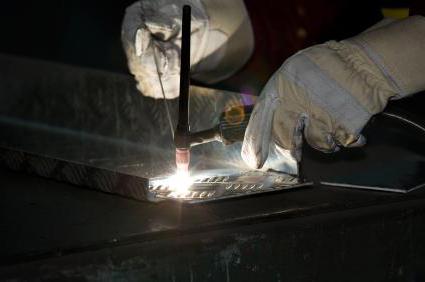
An important condition for the process is the penetration of the oxide film, which is formed on the surface of the workpiece. For this, welding of aluminum with argon is carried out using alternating or constant reverse current. The process cannot be run continuously. direct current. In this case, the oxide film will not succumb to destruction, cathode sputtering will not occur.
Welding can also be divided according to its speed into MIG and TIG (AC). In the first case, the process is 3 times faster, but the quality of the seam is much higher with the second type of work.
materials
Today applies a large number of aluminum alloys. Each has its own physical and chemical characteristics. The filler wire for welding aluminum with argon must be used in a timely manner. If the packaging is already open, it is impossible to store such products for a long time. Oxidized, the surface of the filler wire will be unsuitable for welding aluminum with argon. 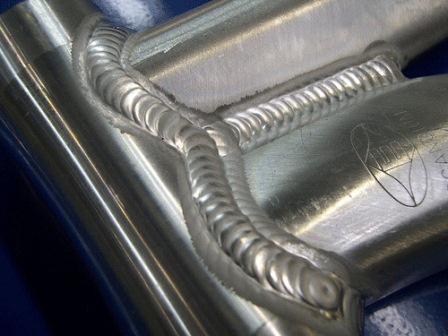
Before carrying out the process, the surface is cleaned of foreign contaminants. Even with a short exposure to air, aluminum is covered with a film of Al2O3 oxide. Such material in the welding process requires the provision of a protective environment from Argon. For this, argon is used.
But it is better to use this gas in a mixture with helium. This allows you to achieve a higher temperature of the weld pool. This is especially important for thick-walled workpieces. In some cases, aluminum welding is performed semi-automatically without the use of argon, but only helium.
Also, the use of a mixture of gases makes it possible to obtain a less porous seam.
Equipment for the welding process
Aluminum argon welding, the technology of which will be discussed later, involves the use of certain equipment. To carry out the process, you will need a TIG AC inverter, which will serve as an alternating current source. It will be required to provide mandatory. Also, before starting work, a filler wire is prepared for welding aluminum with argon. 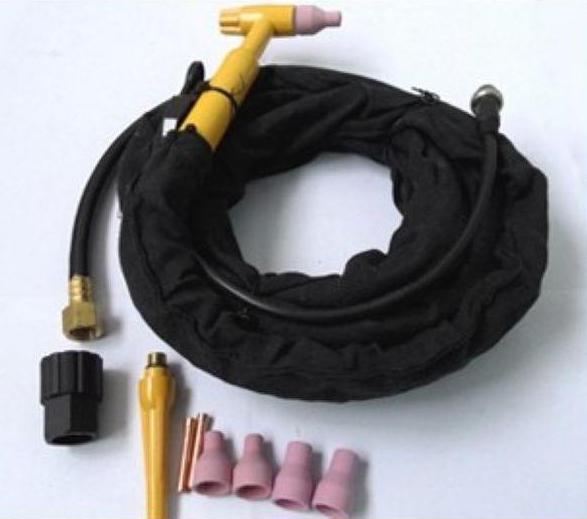
The process involves a TIG torch and a cooling unit for it, nozzles, collets with holders and a gas cylinder. The hose for it must be reliable. The cylinder must be equipped with a gas pressure reducer.
Next, you should provide for an individual protection system. This is a welding shield and mask with tinted glass, quality leggings. Professionals like to use the current control pedal. For a beginner it's not so much. important element because you have to pay attention to other things.
Advantages of Argon Welding
Alternating current welding of aluminum with argon has a number of features. They favorably distinguish this process from its other varieties, provided that the system is used correctly.
Argon during welding will prevent the oxidation of aluminum. This gas displaces oxygen. This approach is universal. Almost all aluminum alloys can be welded by this method. 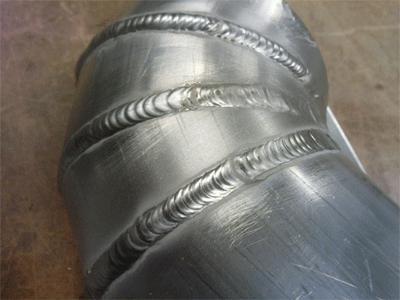
In this case, the stability of the arc will be observed. Seams obtained using solder wire for welding aluminum with argon are strong when using a high-quality apparatus. Therefore, in production conditions, inverters are used only of the highest quality.
At home, only high-quality equipment should also be used. This will ensure the strength and durability of the finished product.
Current type
The filler wire for welding aluminum with argon melts under the influence and creates a seam. In this case, experts recommend using alternating current. This is due to the technology of the process.
Welding aluminum with argon direct current of reverse polarity will allow cleaning the oxide film in a cathodic way, but the welding temperature will be significantly increased. Because of this, even durable tungsten electrodes will begin to break down.
A direct current of direct polarity is simply not able to break the oxide film, although its arc is more stable. Therefore, only switching the polarity is able to give a high-quality result of work.
Preparatory stage of work
Solder for welding aluminum with argon will lie more evenly, and the seam will be stronger if the surface of the material is well prepared before starting work.
The aluminum needs to be degreased first. For this, a solvent is used, for example, acetone or gasoline. Then the surface is cleaned mechanically or chemically. After that, the material must dry if special products were used.
Mechanically, the oxide film can be cleaned with a metal fiber brush or sandpaper. This method is applicable at home. In production, preference is always given chemicals cleaning. The aluminum surface can be etched in an alkali solution, washed with hot and cold water, clarified and finally dried.
Process Rules
Welding aluminum with argon for beginners, the step-by-step instructions for which will allow you to do the work at home, uses refractory tungsten electrodes.
They very often contain additional impurities that increase the strength and quality of the final result.
The main rule to follow in the work is the location of the wire. It must always be in front of the electrode. You can only move it along the seam.
Welding itself is allowed to be carried out in different positions in space. 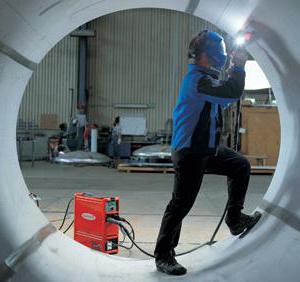 However, the best quality is ensured when the process is carried out horizontally. For welding on the ceiling or on the walls, a mixture of argon and helium is used.
However, the best quality is ensured when the process is carried out horizontally. For welding on the ceiling or on the walls, a mixture of argon and helium is used.
In order to control the process and be able to perform more complex work, the machine adjusts the AC frequency and balance.
Experts note the features of welding aluminum with argon, which beginners should take into account.
The electrode is located as close as possible to the surface to be welded. This will help form a minimal arc. The wire should be fed smoothly, otherwise sharp jerks will cause the material to splatter.
The stability of the arc ensures the vertical position of the electrode. Welding speed must be high. The quality of the final result will depend on this indicator. In order for the seam to turn out to be even and durable, a beginner should practice welding skills before starting work.
Process instructions
The apparatus for welding aluminum with argon initially supplies "mass" to the workpiece. IN left hand the master must take the wire, and in the right - the burner. When the button on the equipment is pressed, the current will turn on and gas will begin to flow. An arc will form between the surface of the workpiece and the electrode. It will melt the filler and the edge of the part. At the same time, the surface will begin to appear
For an experienced master, this process will not be difficult. For a beginner, it will be important to practice a little. 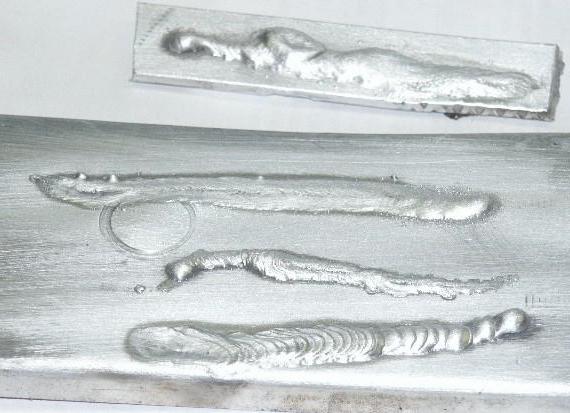 This process has been tested over the years by a large number of specialists. He proved his worth and durability of the end result.
This process has been tested over the years by a large number of specialists. He proved his worth and durability of the end result.
By adhering to the instructions presented, as well as by making several practice applications of solder on a test workpiece, even a novice welder will be able to do the job quite well.
Material consumption
The consumption of argon during welding of aluminum depends on the thickness of the filler wire, and increases according to its diameter. The gas flow rate is set using a float pressure regulator.
If the wire diameter is 1 mm, then 12-14 l / min of argon will be required. With an increase in the solder cross section to 1.2 mm, the flow rate will be 14-16 l / min. For aluminum wire with a diameter of 1.6 mm, inert gas will require 18-22 l / min.
After the end of the welding process, argon must still flow to the surface of the workpiece for some time. This will protect the seam and cool the electrode guides.
Semi-automatic welding without argon
Some types of work require more than high temperature weld pool. In such cases, aluminum is welded with a semi-automatic device without argon. Helium is used for this process. This gas has a higher thermal conductivity, which is an advantage when processing thick-walled workpieces.
Without argon, more complete outgassing occurs, and the seam is obtained practically without pores. Also, a similar technology is used when welding aluminum with direct current. This method is more complex, so it is used much less frequently.
The use of pure helium increases the cost of the process. For welding on walls or ceilings, such an inert gas is simply irreplaceable. It is lighter than air and argon. With the high cost of helium, it is sometimes still used by both home craftsmen and experienced welders.
Having become familiar with the technology of such a process as welding aluminum with argon, for beginners, step-by-step instructions will help you complete all the steps correctly. By taking work seriously, having studied all the nuances and subtleties of its implementation, you can create high-quality seams at home that will last a long time. This is not an easy process, but with a responsible approach it is quite feasible and interesting.
